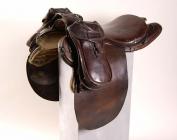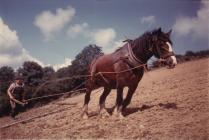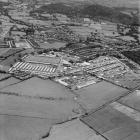Royal Welsh Agricultural Show, Abergele 1950
Items in this story:
The Royal Welsh Agricultural Show - background
The Royal Welsh Agricultural Society was established originally as the Welsh National Agricultural Society in 1904; its aims were to improve the breeding of stock and to encourage agriculture throughout Wales. The first show was held in August 1904 at Aberystwyth and thereafter at 37 different locations, alternating between north and south Wales. The Royal Welsh settled on its present site at Llanelwedd, Builth Wells in 1963, since when it has developed into an annual four-day event and has grown into the most popular agricultural show in Britain.
In 1950 the show was held at Abergele in North Wales and the discovery of a set of aerial photographs taken during the show prompted us to find out more about those three days in 1950....
Massive attendance at the 1950 Abergele show
Although a seaside resort, Abergele has always had strong connections with the local farming community, holding weekly cattle and sheep markets, and, because of a strong breeding tradition locally, a monthly horse sale specialising in Shire horses. It was also sure of a strong attendance because of being a holiday town, with thousands of holiday makers staying at the nearby camping and caravanning sites. The access to the show was well served with buses from Chester and Caernarfon, and a train station with a large siding which could cope with trains of horse boxes within yards of the showground. People travelled from as far away as Hampshire to show their livestock.
1950 was only five years after the end of the Second World War and petrol rationing had only just come to an end two months earlier. This meant that anyone with a car was now finally able to go on trips after eleven years of severe war-time restrictions. This probably boosted numbers over the three days of the show and, with over 60,000 attending, the 1950 Abergele show had the highest attendance figures in the history of the Royal Welsh up to that date.
Shire Horses, livestock and local competitors
The entries chart for the Abergele show is particularly interesting as the number and type of entries reflected the popularity of breeds. The 128 Shire horses entered in two classes highlight the importance of breeding Shires to the Abergele area. It also shows that the numbers had not reduced after the War when 98 shire horses were entered despite the rapid increase in petrol driven vehicles. Why was there an increase in Show Jumping classes from 215 in the previous year to 241 – was Abergele the Welsh centre for this sport at this time? There were also classes for Hunters, and Welsh Ponies. Cattle classes included “Welsh Black” but numbers had declined in Abergele by about a third, and “Shorthorns”, once the most popular breed, were declining in favour of “Friesian” and Ayrshire” breeds that gave a higher milk yield. In the “Other Cattle” class two breeds were included – “Jerseys” and “Guernseys”. The “Welsh Mountain Sheep” classes remained steady, and there was a class for Welsh Pigs.
Prizes for Shire horses were won by locals: J.K Jones (Bryn Elian, Dolwen), J. E. Williams (Ty Newydd, Morfa, Abergele), Trefor Lloyd Jones (Pant Idda, Abergele), Edward Parry (Manorafon, Betws), Edward Owen (Gwernigron, St Asaph) and William Roberts (Ty Mawr, Llysfaen).
The lists of local winners include some well-remembered names and some with a world-wide reputation. The most famous was the late Miss M. Brodrick of Coed Coch, a name synonymous with Welsh Mountain ponies. Ponies shown by her won four firsts, six seconds, three thirds, two fourths and one reserve prize. Ponies bred by her also won a host of prizes. Her ponies were at the same time having equal success in every major show in the United States, the Empire and Europe.
The showground at Abergele
The Aerofilms photograph above shows the huge extent of Abergele Royal Welsh showground. The weather during the three days of the show was warm and sunny, the field was packed with happy smiling faces, the caterers were busy, and the traders on their 236 stands were obviously pleased with the public reaction, for everyone could enjoy their stands without charge. The craft and other tents were full of exhibits and, most importantly, the farmers and their families were enjoying themselves in the summer weather – a sure sign it was a good show. The animals were housed on the field and one could view them at close quarters as well as en-masse while the various competitions were judged and then when they were paraded around the main arena. There were also competitions for horse riding, jumping and driving – all very exciting.
The site is now occupied by the Maes Canol housing estate.
Spectacular displays by Liverpool Mounted Police
During the 1950 show the Boys Regiment, Royal Artillery, gave displays in the main arena which was a large rectangular fenced off area. The fencing was only a rope and looked particularly flimsy when a line of huge bulls was being paraded behind it. Fortunately they all appeared to be basking in the glory of the event and appreciating the applause. Perhaps the most interesting event was a demonstration by the Liverpool Mounted Police which, at the time, boasted the largest mounted contingent in Britain as they regularly patrolled the docks and were present at football matches and race meetings, including the Grand National. They were all in full dress uniform with plumed helmets carrying lances and, in the case of the inspector, a drawn sword. They were accompanied by the Mounted Police band and put on a display of highly skilled horsemanship. For the grand finale they all rode down to the far end of the arena, formed a line side by side behind the inspector, he drew his sword, the riders lowered their lances and the inspector shouted “Charge”. They were galloping hard towards the far end of the arena and towards a long line of terrified visitors, some of whom had broken and started to run for their lives. With perfect timing the Inspector raised his sword upright and the charge stopped only inches from the flimsy rope fence.
There was something for everyone at the Show and certainly that all those who remember it will feel a little sad that it will probably never visit Abergele again. The site at Llanelwedd is large with commodious covered buildings and is well worth a visit for it is a valuable and viable asset to the agricultural community. But there is a downside for the peripatetic shows not only involved local farmers from a very wide area but caused great excitement and interest among the rest of the local population and resulted in many members of the local community becoming much more interested, and more informed and knowledgeable about agriculture.
If you have any memories of the 1950 Abergele show, or any past Royal Welsh show please add them to the comments box below. Photographs of any of the shows would be great to have on the site, please upload any yourself or get in touch via the contact form.
Helen Rowe (RCAHMW).
Reference: Article written by Vernon Hughes in Abergele Field Club & Historical Society Review No. 19




